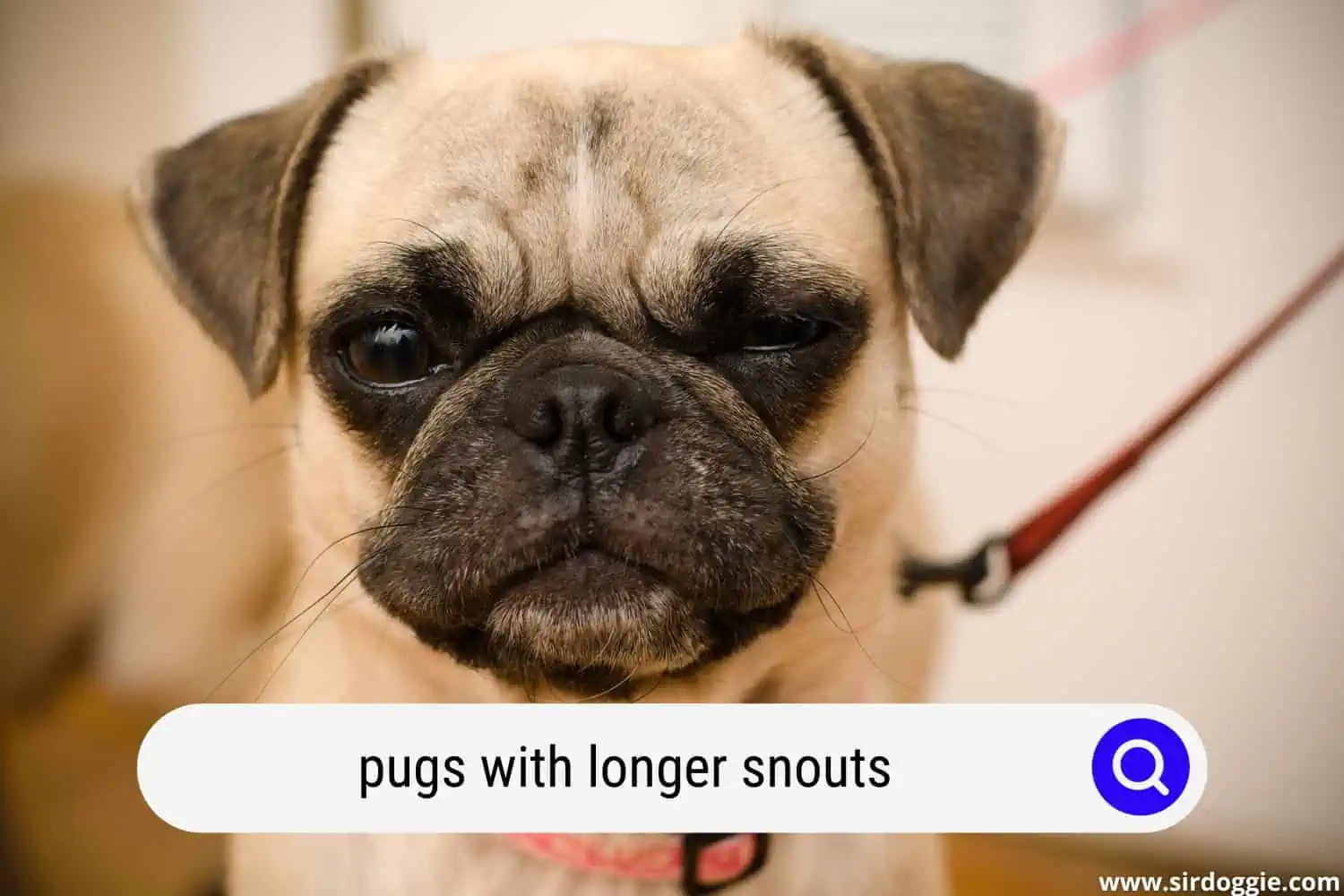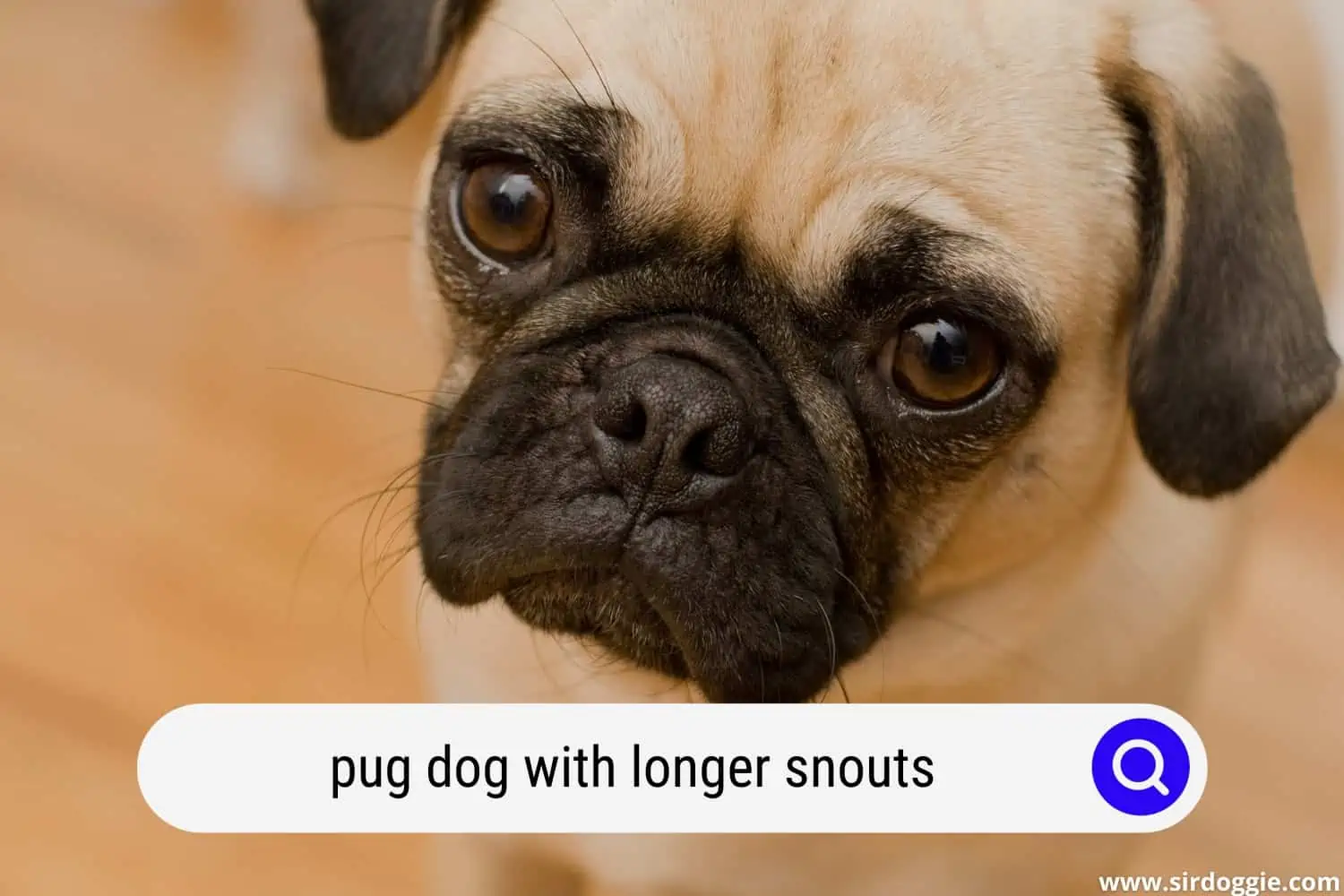Pugs with Longer Snouts
Pugs are a toy breed dog, small and stocky. They usually have bulging eyes, short strong legs, and a flat face. Well, this type of “visage” is what is causing many breathing problems, and consequently, a shorter life span. So, breeders out there needed to come up with a solution to extend the life of such a precious little fella by crossbreeding it with a longer-faced breed. And what they did was to breed a Pug with a Jack Russel Terrier. That is how the world got Pugs with longer snouts.
Terriers have long faces and are very active and curious, therefore this breed seemed like a perfect interbreeding candidate. But when you mix the two breeds, long-nosed Pug temperament and behavior patterns could be unpredictable, because, after all, it won’t be a purebred dog. Therefore, it may or may not have all the qualities of a Jack Russel Terrier parent. Now, let’s look in more detail at the Retro Pug breed: history, temperament, health, and nutrition needs.

History Of The Breed
So the nose Pug or Retro Pug came into the picture in 20th century Germany when breeders started thinking about brachycephaly treatment options for them. A shorter snout was giving pups a lot of breathing problems as well as a low tolerance for heat. Therefore, crossbreeding a Pug with a different canine kind seemed like a logical solution. That’s how the Pug was mixed with the Jack Russel Terrier and we got a new, long-nosed Pug, or Retro Pug, breed.
Later on, one breeder from Sweden created a Retro Pug club and started to develop the right breed standards all long-nosed canine fellas had to adhere to (like the right weight, height, face length, etc.).
Read more about: How Much Does A Puggle Cost?
Why Going Retro?
Since Retro Pugs are very friendly, loyal, and loving, they make perfect house pets. And they don’t require a big living area to roam around in. Whether it’s a small apartment or a big house, they will do just fine in any space. The biggest they are going to get is 18-20 lbs, which is typical for a toy breed.
Long-nosed Pugs thrive in a household that has children or other pets: they need constant socialization. And their Russel Terrier gene makes them very active as well as playful. So, when you feel like you don’t have time to give them the necessary attention, they can play with your kids or other canine siblings to burn off some of that built-up energy.
And a very solid reason to get the Retro hybrid: if you were eyeing Pugs for a while but were worried about their numerous health issues (breathing, skin, eyes, etc.), now you have less to worry about. With Retro Pug you can be sure some of these issues are not going to come up. The Jack Russel gene will give them healthier skin, better breathing (because of the longer snout), and a more vibrant personality.

Temperament and Behavior
As mentioned above, Retro Pugs are very lively creatures, with a ton of energy (more than the regular Pug breed).
They crave attention, so if they want to come snuggle on a couch with you while you are talking on a phone, or read a book-don’t shoo them away. They need to feel your energy and vibes, it makes them feel secure.
Retro Pug is very friendly, therefore you don’t have to worry about its reaction to your neighbors or friends when you invite them over for dinner. They will be a hit with your pup as it is always eager to make new friends.
And its intelligence just stuns: you will be surprised how quickly it will learn how to sit and stay, bring you slippers, or play fetch with you.
They do get stubborn occasionally (typical Pug gene), but it is actually fun to see how their personality unravels. It is worth explaining to them why you want them to do something, especially if the reward will follow the training session. They need to respect you to follow your lead, therefore you will feel like you need to be a role model pet parent, and a better version of yourself.
Caring for the Retro Pup: Health, Exercise, and Nutrition
- Nutrition: make sure you feed your long-nosed friend good-quality dry food. Hills Science Diet is one great brand to go with as it has a great reputation among pet parents worldwide. Also, don’t forget to give it plenty of water throughout the day.
- Exercise: Retro Pugs need more vigorous types of activities every day (compared to their shorter-faced relatives). Therefore, make sure you provide some kind of exercise (daily walks work great) every day along with playtime.
- Training: pugs are very smart, therefore they pick up on training techniques relatively quickly. Be sure to use positive reinforcement and praise more than reprimanding (although there’s nothing wrong with the latter, for an extremely mischievous pal).
- Health Issues: those big eyes are unfortunately susceptible to various vision issues, so be sure to consult with your local vet if you notice anything strange in your dog’s behavior. For example, constant eye-rubbing, bumping into walls, missing its food bowl while eating, etc. could be signs of something serious.
Also, their skin is very sensitive and might be prone to allergies. Be sure to scan your long-faced pal’s coat and skin for any dryness, irritation, and rash. Make sure your pup doesn’t overheat in the summer, as it may cause difficulties breathing and even stroke. Take it for a walk only when the sun is the weakest (early in the morning or late at night).
Curl-Up
Bringing home a puppy is always exciting, but nerve-wracking at the same time. You have to think about getting along with the other family members, including your other canine counterparts. And if you love Pugs, why not try to adopt a Retro Pug fella? It will have a lot fewer health issues, a very lively personality, and the smarts you just won’t believe.
Good luck in finding your new long-nosed friend!
Related Reading: What Is A Pug Nose?

Family Dog Expert Author
Hi there! I’m Stuart, a devoted dog lover and family dog expert with over a decade of experience working with our furry companions. My passion for dogs drives me to share my knowledge and expertise, helping families build strong, loving bonds with their four-legged friends. When I’m not writing for SirDoggie, you’ll find me hiking, playing with my beautiful dog, or studying music.